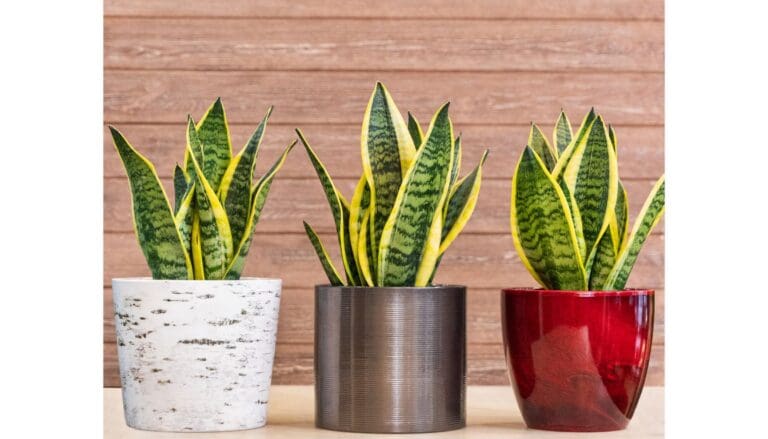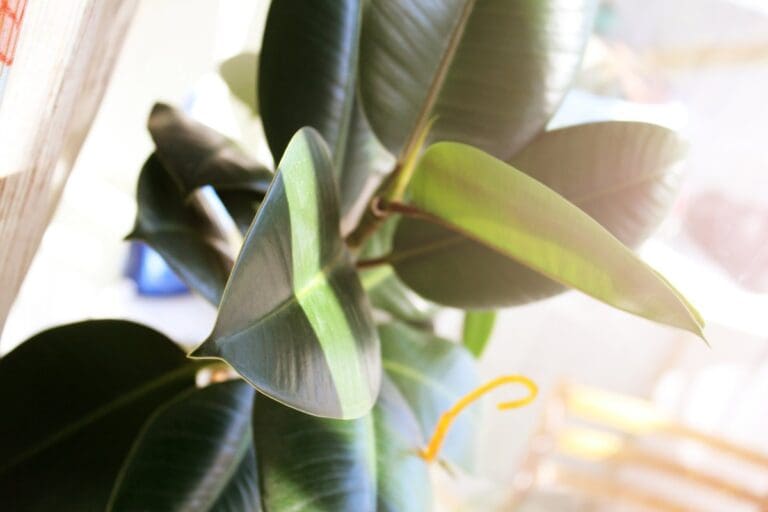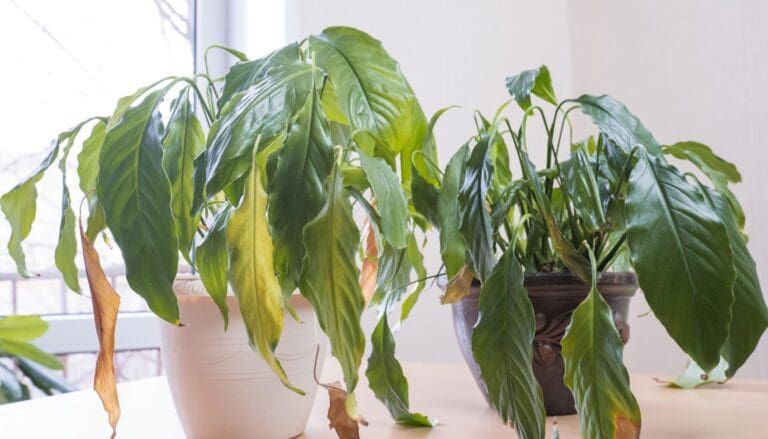Snake Plant Care Guide: Thrive with These Simple Tips!
If you’re on the lookout for a low-maintenance companion that’ll stick with you through thick and thin, let me introduce you to the snake plant, a.k.a. Mother-in-Law’s Tongue.
Sporting strappy, upright leaves, it’s the epitome of plant chic, and it’s so tolerant, it won’t throw a fit even if you neglect it for a bit.
I’ve found that mine thrives on benign neglect – who knew a plant could be such an easy roommate?
Snake plants are like the introverts of the plant world; they love a cozy corner with indirect sunlight and can manage just fine with less than perfect conditions.
A little morning sun won’t hurt, but like some of us before our coffee, too much direct exposure can make them cranky (read: leaf burn.)
Plus, with their funky vertical lines, they’re natural air purifiers – take that, stale indoor air!
Have you ever forgotten to water a plant? 🌱 No judgment here – we’ve all been plant-parent distracted at some point.
The good news is, snake plants are drought-tolerant! They actually prefer it if you wait until the soil is dry before offering them a drink.
Overwatering? Nah, they’re not into that.
Share a pic of your snake plant on our facebook page, or tell me, are you a serial overwaterer or a forgetful waterer? Let’s grow our plant care skills together! 🌿✨

Please note: Simplify Plants is reader-supported. Some links in the post are affiliate links and I get a commission from purchases made through links in the post.
Choosing the Right Species
When it comes to selecting a snake plant for your home, the variety of species available means there’s a perfect fit for every plant parent out there!
Size does matter, and the leaf design adds that personal touch to your space. Let’s get into making your choice easier—isn’t it exciting to find the perfect green buddy?
Size and Growth Patterns
Do you have a cozy little corner that’s begging for some green love? Or maybe a spacious area that could use a tall, statement piece?
Snake plants range from the petite Sansevieria trifasciata ‘Hahnii’, growing only about 6 inches tall, to the impressive Sansevieria trifasciata ‘Laurentii’, which can shoot up to 4 feet!
My advice: measure the spot where you’d like to introduce your leafy pal, and remember, snake plants like to have their space.
Leaf Varieties and Colors
Green, yellow, silver-striped or even almost-black—snake plants truly wear a rainbow of greens!
Want something bold? Go for the dramatic ‘Black Gold’ with its dark foliage and bright golden edges.
More into subtle elegance? The ‘Moonshine’ variety has silvery leaves that seem to glow.
Mix and match your favorite ones to create a tableau of textures and hues. It’s like being an artist but with plants 🎨🌿!
So tell me, which snake plant species caught your eye? Have you already pictured where it’s going to live in your space? Share your thoughts, and let’s get our green thumbs buzzing! Don’t forget to hit like and share this with your fellow plant enthusiasts! 🌱💚
Proper Planting Techniques
If you’re like me, you love watching your green buddies thrive.
So let’s get our hands dirty with some prime planting techniques for our resilient friend, the snake plant. 🌱
Suitable Soil Mix
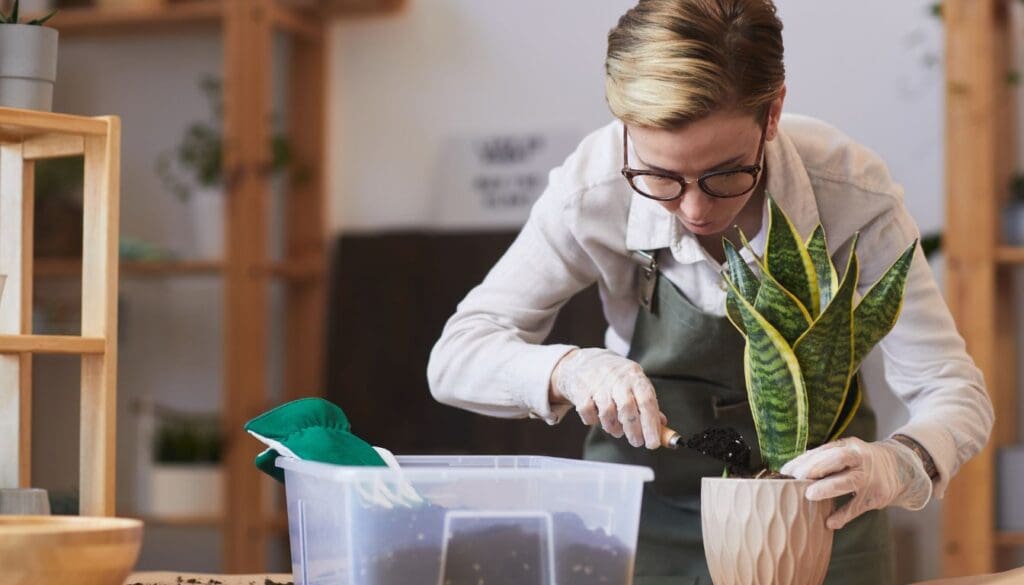
First up, soil! I swear by a well-draining potting mix—you know, the kind that makes you feel like a proud plant parent when your snake plant is sitting pretty without water-clogged toes.
Think about adding some perlite or sand to the mix to keep it light and airy. Trust me, your plant’s roots need to breathe!
- Ideal Soil Composition:
- 60% potting soil
- 30% perlite or coarse sand
- 10% compost
Appropriate Containers
Now, let’s talk containers.
Size does matter here—too big, and the soil stays damp, hello root rot. Too small, and your plant’s growth gets stunted.
Aim for a pot that’s just right for Goldilocks’ plant. Plus, make sure there’s a drainage hole at the bottom.
Waterlogging is a no-go for these drought-loving darlings. 🚫💧
- Recommended Pot Size: Choose a pot that is 1-2 inches larger in diameter than the current one.
Planting Depth and Spacing
And finally, planting depth and spacing.
Deep enough to let the roots spread out comfortably, but not so deep that the base of the plant is below the soil surface.
As for spacing, if you’re doing a snake plant meet-up in a larger container, keep them about 2 inches apart to give each one its personal bubble. 📏✨
- Planting Guide:
- Depth: Plant level with the top of the soil
- Spacing: 2 inches apart (if planting multiple in one pot)
Have you got any go-to mix recipes or pot picks for your snake plants? Drop them in the comments—I’m all ears and can’t wait to hear what’s worked for you! And if you find these tips helpful, don’t be shy—share them with your plant-loving pals! 🌟
Light and Temperature Requirements

When I think of a resilient houseplant, the snake plant (also known as Sansevieria) is one of the first to come to mind.
They’re tough, but to see them thrive, lighting and temperature can’t be neglected. Let’s break down what they love best!
Ideal Light Conditions
Indirect sunlight is like a spa day for these leafy friends! Snake plants prefer 8 to 10 hours of it.
Ever caught them basking in a few hours of early-morning rays? That’s because a touch of direct sun gets their engines running—just not too much or they might get a sunburn.
- Perfect Spot: A north-facing window where the light is like a soft hug.
- Avoid: The blazing afternoon sun which is more like a noogie than a hug.
You’ve probably seen them chilling in darker corners too, right?
They can handle some shade, but too little light? Think of a dimly lit room as the equivalent of putting on sunglasses indoors—not great for showing off their vibrant colors.
Temperature Tolerance
Imagine if the Snake Plant could wear a t-shirt that says “I’m cool with the cool, but not too cool.”
They love temperatures between 60-80°F (15-27°C).
They’re not fans of the cold, so if it dips below 50°F (10°C), your leafy pal might start to protest.
- Summer Feels: They can handle the heat but prefer not to be in a stuffy, hot corner. Think of how you feel on a warm day with a gentle breeze—that’s their happy place.
- Winter Blues: Drafty windows or doors? They’ll shiver right alongside you.
It’s all about finding that comfortable room temperature—cozy enough for you to relax in, perfect for the snake plants to kick back too. And remember, no sudden temperature changes. These guys dislike drama, just like me! 😌🌿
Don’t forget to share your snake plant’s favorite spot in the comments! Is it basking in the morning light or thriving in that well-lit office space of yours? Let’s chat! ⬇️🌱
Watering and Humidity
Guess what? Keeping your snake plant happy is easier than you think, especially when it comes to watering and humidity. Let’s dive straight in!
Watering Schedule

I always tell my friends, “Think of your snake plant as that low-maintenance buddy who only needs to hang out now and then.” 🌱
Here’s my go-to watering checklist:
- Check the soil: Peek at the top 2-3 inches of soil every week; if it’s dry, it’s time to water.
- Season matters: I up my watering game slightly during spring and summer, aiming for once a week. And when winter rolls in? Every 2-3 weeks is enough.
Humidity Preferences
Snake plants are pretty chill when it comes to humidity. They’re like, “Hey, I can handle that average home vibe.” But here’s the scoop:
- Ideal range: Aim for 30-50 percent humidity to keep your leafy friend comfortable.
- Keep it warm: Don’t let the temps drop below 50°F, because, let’s be honest, no one likes cold feet!
So tell me, how often do you find yourself watering your green buddies? 💦
Got any cool tips or quirky plant stories? Drop a comment below and let’s swap some plant tales! 🌿✨
Fertilization and Nutrients

Caring for my snake plant isn’t just about water and sunlight; it’s a bit like a cooking show for plants, where the right mix of nutrients plays a starring role! 🌟
Fertilizer Types
In the great pantry of plant nutrition, I have two main choices: a balanced, water-soluble fertilizer or slow-release granules.
No complicated recipes here – a simple 10-10-10 blend does the trick. That’s equal parts nitrogen, phosphorus, and potassium for those who skipped science class! 🧪
For liquid lovers, it’s as easy as mix, pour, and watch the magic happen.
Just remember, moderation is key; think of it as seasoning your favorite dish. A little goes a long way!
Feeding Frequency
Ever wondered how often to treat your snake plant to a nutrient feast? 🍽️
Twice a year is my go-to schedule – usually during the growing season (spring and summer).
It’s like breaking out the holiday recipes for those special occasions.
Cutting the recommended dosage in half prevents that “too much of a good thing” scenario, avoiding the plant equivalent of a food coma. 🥱
So, who’s ready to whip up some plant food gourmet style?
And hey, if you’ve got your own fertilization tips or tricks up your sleeve, why not share in the comments? Let’s grow together! 🌱💬
Pruning and Maintenance
When I think about keeping my snake plant looking sharp, it’s all about regular maintenance and a keen eye for pruning. Let’s slice into the nitty-gritty of keeping those leaves looking fabulous! 🌿✂️
Trimming Dead Leaves
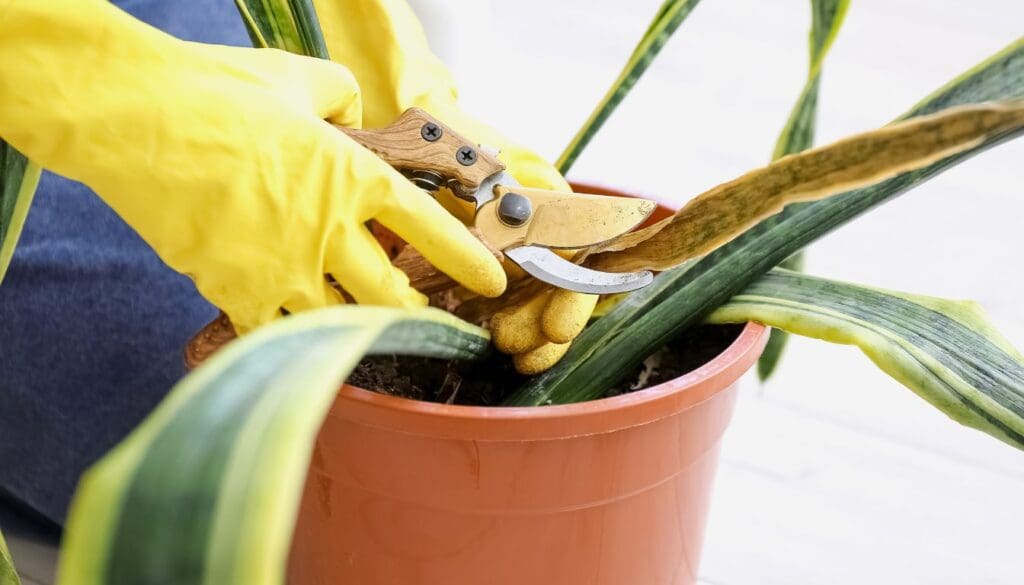
No one likes a scruffy plant! I check my snake plant for dead or dying leaves that scream for a snip. Here’s my quick guide:
- Spot the duds: Leaves that are more than 50% yellow or brown.
- Snip with care: Cut as close to the soil line as possible with a sharp knife.
It’s like giving your plant a fresh haircut – out with the old, in with the new! And remember, after trimming, your plant is not only healthier but ready for its plant selfie. 📸
Dust and Pest Control
Have you ever wondered if your plant needs a spa day?
Dusting your snake plant’s leaves not only keeps them shiny but also wards off pesky pests.
Gently wipe the leaves with a damp cloth; it’s like a mini-facial for your green buddy.
For pest control, keep an eye out for unwelcome freeloaders like spider mites.
A little neem oil can go a long way in sending those bugs packing.
Repotting and Propagation
If you’re a proud parent of a snake plant, you know they’re as tough as boots! But even these hardy green friends need a little TLC sometimes.
Let’s talk about the when and how of repotting and the fun of propagation. 🌱
When to Repot
Did you know that snake plants prefer to be a bit cramped? It’s true! 🤏
But once you see roots poking out of the drainage hole, it’s time for a move.
Repotting is typically needed every 2-3 years. It’s not just about room to grow; it’s also an opportunity to refresh the soil and check the roots for health.
Do your leaves droop? Is the soil drying out faster than a deserted watering hole? These are all whispers for a change.

Propagation Methods
Propagating a snake plant is like sharing a secret recipe – it’s a gift that keeps on giving!
There are a few ways to do it, but let’s talk about the easiest two.
Division: When you’re repotting, you’ll often find that your snake plant has naturally split into multiple sections. Each of these has its own set of roots.
Just separate them gently at the root level and pot each in its own container. Easy as pie!
Leaf Cuttings: Got a healthy leaf? Great!
Snip a sizeable portion and let it callous over for a day or two. Then, pop it into some soil and play the waiting game.
Pro tip: Keep it slightly moist and be patient – it might take a few weeks to see some action. 🕰️
Propagation is like a magic trick: one plant turns into two, two turn into four, and so on – isn’t that just mind-blowing? 🤯
Share your propaga-snips and repot-riumphs in the comments! Let’s grow this plant community together. 🌿✨
Troubleshooting Common Issues
Oh boy, isn’t it just a joy having a snake plant around? These green buddies are tough cookies, but sometimes they cry out for our help in subtle ways. Here’s how I keep my leafy friends happy and healthy—I’ve dealt with a few issues along the way!
Signs of Overwatering
Have you seen your snake plant looking a little less perky than usual? Check the soil moisture—these guys dislike wet feet. Here’s what to look out for:
- Leaves turning yellow: Oof, classic sign. It’s like they’re saying, “Ease up on the agua, buddy!”
- Mushy, soft base: It feels like a sad, overripe banana.
What can you do?
First, let the soil dry out before you even think about giving it more water. Consider replanting in fresh soil if it’s really soggy.
Remember, it’s a desert plant at heart—keep it on the drier side. 🌵
Spotting Pests and Diseases
You might think, “Pests? In my snake plant?” Yup, it happens to the best of us! But here’s how you can play detective:
- Spider mites: Teeny tiny spidey parties that look like small white webs. Not cool, eight-legged fiends! 🕸️
- Mealybugs: These look like little cotton puffs, but don’t be fooled—they’re up to no good.
To evict these unwelcome guests, wipe down the leaves with a soft cloth dipped in soapy water.
For tougher cases, insecticidal soap or neem oil is like showing them the door.
Snake Plant Falling Over or Bending Leaves
Is your snake plant doing a leaning tower of Pisa impression? It might just be top-heavy. Here’s what I’ve seen:
- Pot too small: Like trying to fit into jeans from high school. Time for an upgrade!
- Weak roots: They need a bit more oomph to hold up those tall beauties.
Pro tip: Give it a new, roomy pot to stretch out in and some fresh soil to help strengthen those roots. 🏋️
Tips to Get Your Snake Plants to Grow Taller
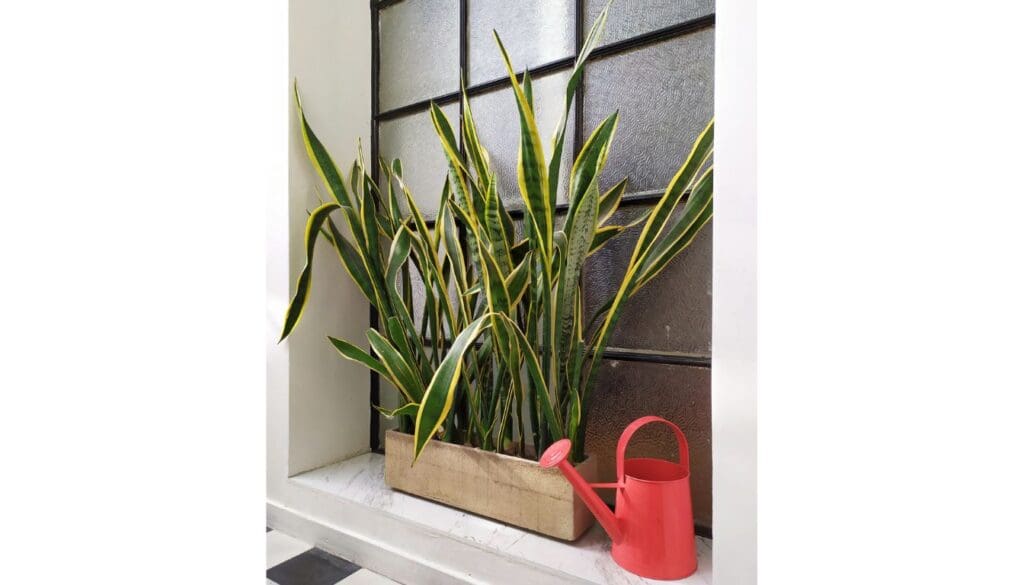
Have you ever looked at your snake plant and thought, “Grow, baby, grow!”? I sure have, and let me tell you, with a few simple tweaks, you can encourage those stoic greens to reach new heights. 🌿✨
Sunlight Is Your Friend
First things first, these plants love a good sunbath. Make sure to place your snake plant in a spot where it can bask in some bright, indirect light.
Too much direct sunlight can scorch the leaves, but just enough will cheer them on to grow taller.
Water Wisely
Remember, it’s all about balance. Your snake plant doesn’t need a daily drink; it’s more of a “hydrate responsibly” kind of buddy.
Water the soil thoroughly, only when it’s completely dry. The last thing you want is to drown your plant with love, literally.
| Don’ts | Dos |
|---|---|
| Overwatering | Waiting for soil to dry |
| Direct harsh sunlight | Bright, indirect light |
Is it growing season (spring and summer)? Treat your plant to some light fertilizer. But go easy—too much and you’ll overwhelm it. Just a little snack to encourage those leaves to stretch out.
Support with Love
Got a tall leaf flopping over? Prop it up!
Use a soft tie or stake to give it the hint to stay upright. It’s like saying, “You can do it!”
FAQs
Ever find yourselves wondering how to keep those stoic snake plants thriving? Let’s get straight into some quick-fire FAQs to turn that brown thumb green! 🌱
Can snake plants handle direct sunlight?
Nope, my leafy friends prefer the chill vibes of indirect sunlight. A bit of morning sun is cool 😎, but too much will give them a sunburn. Ouch!
How do I know when to water my snake plant?
Here’s a hack: poke the soil with your finger.
If it’s dry, your plant is saying, “Gimme a drink!” But if it feels like a damp afternoon in London, hold off on the H2O 🚱.
What’s up with yellow leaves?
Yellow leaves are no cause for an SOS—let the soil dry out, and your plant will be back on track.
Remember, you can’t undo overwatering. Be as stingy with water as I am with my last piece of chocolate! 🍫
Do snake plants clean the air?
Get this: snake plants aren’t just pretty faces; they moonlight as air purifiers! How’s that for multi-tasking? 🌬️💨
Conclusion
Caring for my snake plant has been a breeze! I’ve learned to strike a balance with watering, making sure the soil is dry before giving it a drink.
If you’ve got one, you’ll know snake plants are like the chill friends in the plant world – they don’t need us fussing over them all the time. 😌
Here’s a quick checklist I follow:
- Water sparingly to avoid overhydration.
- Give it a spot with indirect sunlight; think of it as the plant’s sunscreen. 🌞
- Watch for slow growth; it’s their laid-back nature, not a cry for help!
Am I the only one who talks to my plants, or are there fellow green whisperers out there? I say, “Grow, baby, grow!” and it somehow seems to work. 🗣️🌱
Remember, patience is key. The snake plant isn’t the type to sprint; it prefers the marathon. 💪
And the payoff is a sturdy, air-purifying buddy that sticks around for the long haul.
How about you? Have you picked up any snake plant care tips? Share your stories or pics below – I’d love to see your green companions thriving! 📸💬
P.S. – Sharing is caring! If you found these tips helpful, pass them on to a fellow plant lover! 🔄
Recommended Garden Supplies
| Product Image | Our Recommended Gardening Supplies | Check Offers! |
|---|---|---|
Top Top
Top
Top
Top
Top
Top
Top
Top | rePotme Houseplant and Tropical Classic Potting Soil Mix | Check Offer On Amazon |
 Top
Top
Top
Top
Top
Top
Top
Top | Espoma Organic Indoor Plant Food | Check Offer On Amazon |
 Top
Top
Top
Top
Top
Top
Top
Top | GooingTop LED Grow Light 6000K Full Spectrum Clip Plant Growing Lamp | Check Offer On Amazon |
 Top
Top
Top
Top
Top
Top
Top
Top | Soil Moisture Meter | Check Offer On Amazon |
 Top
Top
Top
Top
Top
Top
Top
Top | Govee Hygrometer Thermometer, Bluetooth Enabled! | Check Offer On Amazon |
 Top
Top | LEVOIT Humidifiers for Large Room(Best For Plants) | Check Offer On Amazon |
 Top
Top
Top
Top
Top
Top
Top
Top | Upgraded DIY Automatic Drip Irrigation Kit, 15 Potted Houseplants Support | Check Offer On Amazon |
 Top
Top
Top
Top
Top
Top
Top
Top | Stainless Steel Heavy Duty Gardening Tool Set | Check Offer On Amazon |
 Top
Top
Top
Top
Top
Top
Top
Top | Bonide Insecticidal Soap | Check Offer On Amazon |
 Top
Top
Top
Top
Top
Top
Top
Top | Bonide 32 oz Spray Neem Oil for Organic Gardening | Check Offer On Amazon |
 Top
Top
Top
Top
Top
Top
Top
Top | Garden Safe Fungicide | Check Offer On Amazon |

